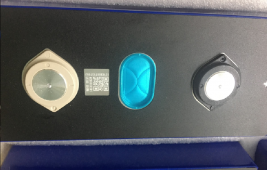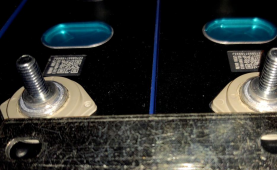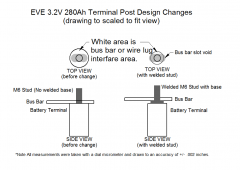JimStLaurent
New Member
- Joined
- Apr 19, 2021
- Messages
- 13
First off, I've been lurking here on the forum since mid March, reading learning a lot from everyone that contributes . For this I'm very grateful and thank you!
Now my concerns, I recently receive a set of 4 Grade A 3.2V 280Ah cells from Shenzhen Luyuan Technology Co., LTD via Alibaba.
In an attempt to fix a mechanical problem with the terminal stud posts, they recently opted to weld M6 studs onto the existing terminals. A base was added to the M6 stud that now reduces the battery terminal to lug area interface to about 20% of what is was, best case guess is 25%. This will increase the current density (amps/unit area) and with it goes temperature. My intuitive thoughts are this is bad because of the potential for premature end of life due to increased temps at this sensitive interface area x8. I don't think the threaded post is contributing much to the 150A current dispersion because I believe the SS washer and nut resistance is much higher than aluminum terminal and welded post. But this is me guessing the material composition of these components.
I've raised my concerns with Amy (Alibaba sales support), intermediary to manufacturer engineering. Their response was to be care if drilling out the posts and report back any testing results. I told them I purchased a set of Grade A batteries and they are responsible for all the testing to ensure this manufactering change has no impact the expected cell life cycle.
My goal here is multi-pronged.
Get a discussion doing with the experts on this forum for their collective options on the situation. I'd like feedback on my assumptions of pumping 150A at .5C through an area ~ 1/5th of what is was before this change. This is one of those times I'd really like to be disproved.
If I am correct, to leverage the weight of forum to hold the manufacturer accountable to remedy the problem. This is my first purchase from both Alibaba and EVE, hopefully it’s not my last.
To make others who have recently purchased or about to receive new cells from Shenzhen Luyuan Technology aware of the potential problem. And to see if anyone else with this new manufacturing build has noticed hotter than normal terminal post connections. I've done nothing with mine yet, except mechanical measurements.
Here are some images to support my concerns.
First image - Shows original (old) cell terminal post suface area

Second image - show (new) elevated, reduced area welded stud cells next to aluminum bus bar with elongated mounting slot

Third image - 2D CAD scaled drawing showing contact interface area changes.

thanks in advance,
Jim
Now my concerns, I recently receive a set of 4 Grade A 3.2V 280Ah cells from Shenzhen Luyuan Technology Co., LTD via Alibaba.
In an attempt to fix a mechanical problem with the terminal stud posts, they recently opted to weld M6 studs onto the existing terminals. A base was added to the M6 stud that now reduces the battery terminal to lug area interface to about 20% of what is was, best case guess is 25%. This will increase the current density (amps/unit area) and with it goes temperature. My intuitive thoughts are this is bad because of the potential for premature end of life due to increased temps at this sensitive interface area x8. I don't think the threaded post is contributing much to the 150A current dispersion because I believe the SS washer and nut resistance is much higher than aluminum terminal and welded post. But this is me guessing the material composition of these components.
I've raised my concerns with Amy (Alibaba sales support), intermediary to manufacturer engineering. Their response was to be care if drilling out the posts and report back any testing results. I told them I purchased a set of Grade A batteries and they are responsible for all the testing to ensure this manufactering change has no impact the expected cell life cycle.
My goal here is multi-pronged.
Get a discussion doing with the experts on this forum for their collective options on the situation. I'd like feedback on my assumptions of pumping 150A at .5C through an area ~ 1/5th of what is was before this change. This is one of those times I'd really like to be disproved.
If I am correct, to leverage the weight of forum to hold the manufacturer accountable to remedy the problem. This is my first purchase from both Alibaba and EVE, hopefully it’s not my last.
To make others who have recently purchased or about to receive new cells from Shenzhen Luyuan Technology aware of the potential problem. And to see if anyone else with this new manufacturing build has noticed hotter than normal terminal post connections. I've done nothing with mine yet, except mechanical measurements.
Here are some images to support my concerns.
First image - Shows original (old) cell terminal post suface area

Second image - show (new) elevated, reduced area welded stud cells next to aluminum bus bar with elongated mounting slot

Third image - 2D CAD scaled drawing showing contact interface area changes.

thanks in advance,
Jim


